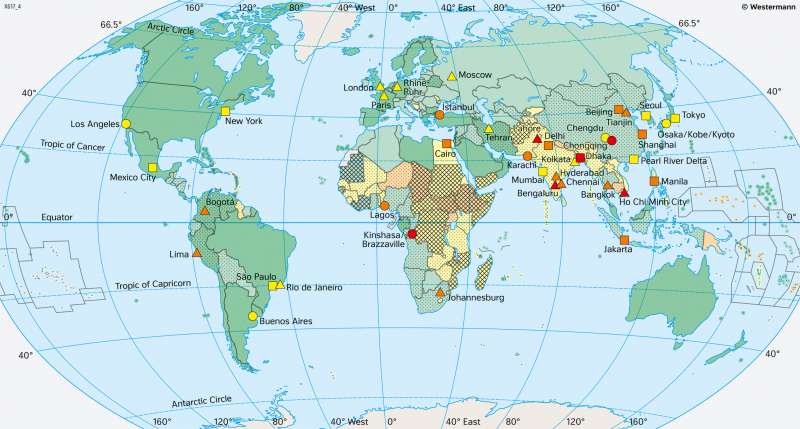The World - Urbanisation
Population
978-3-14-100890-6 | Page 37 | Ill. 4

Overview
While in 1950 around 70 percent of all people worldwide still lived in rural areas, in 2006, for the first time in human history, there were as many inhabitants in the city as in rural areas. And this trend towards urbanisation has continued unabated ever since: in 2018, 55 per cent of all people already lived in cities, and in 2030, according to current forecasts, urban residents will account for 60 per cent of the world's population, and by 2050 their share is expected to rise to 70 per cent.
Urbanisation in industrialised and developing countries
The degree of urbanisation in all industrialised countries - according to the United Nations definition, this includes all of Europe, North America, Australia, Japan, and New Zealand - and some of the emerging countries is already at least over 50 percent today, and in large part over 75 percent. On average, the industrialised countries have an urbanisation rate of 77 percent. In these countries, where the trend towards urbanisation already began with the onset of industrialisation in the late 18th and 19th centuries, the process is essentially complete today. Although there will continue to be urban growth centres, experts expect only a comparatively moderate increase in the urban population over the next 25 years.
In contrast, many large cities in emerging and developing countries, where the urbanisation trend has intensified massively since around 1975, will continue to experience particularly strong growth in the near future. In these countries, urbanisation is an indicator of a development gap between urban and rural areas that is typical for developing countries and includes massive structural problems. The urban population there is growing both rapidly and uncontrollably due to the lack of employment opportunities in the countryside. This tendency is reinforced by natural population growth, which is often above average in developing countries. Since the expansion of urban infrastructure cannot keep pace with population growth, slums and poor neighbourhoods have expanded uncontrollably in many urban centres in recent decades. As the map shows, the slum population now accounts for a significant share of the urban population, especially in the emerging and developing countries of the Southern Hemisphere. In Brazil alone, the favela population grew from 6.5 million to 11.4 million between 2000 and 2010 (next census 2020).
Megacities
In 2005, 20 so-called megacities with a population of more than 10 million people were registered worldwide for the first time. Their number has now grown to 39. Six of them are in Latin America and 22 in Asia.
As can be seen clearly in the map, almost all megacities that recorded significantly disproportionate growth of over 40 percent between 2000 and 2018 are located in emerging and developing countries, where the pressure on cities is particularly high due to the interplay of urban-rural divide and population growth. This in turn leads to more and more people having to live in conditions characterised by extreme poverty, oppressive housing conditions, catastrophic hygienic deficits and a general lack of prospects.
A characteristic of structurally weak countries in particular is the formation of Primate Cities, an urban centre of national importance, which is often, but by no means necessarily, identical with the capital. Primate cities are often characterised by above-average economic and population growth, central capital and trade functions and a supraregional cultural impact. Moreover, there are no other cities of comparable importance within the national city system. This phenomenon can be observed in recent times especially in many African countries such as Senegal, Liberia, Somalia or Chad, but also old European capitals such as London and Paris have essential features of such a Primate City.




